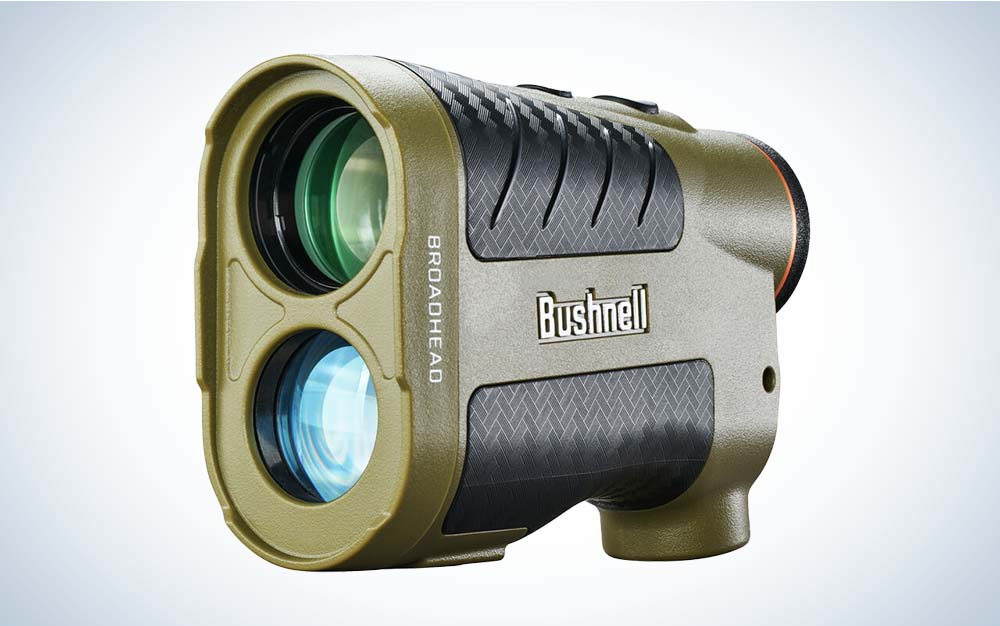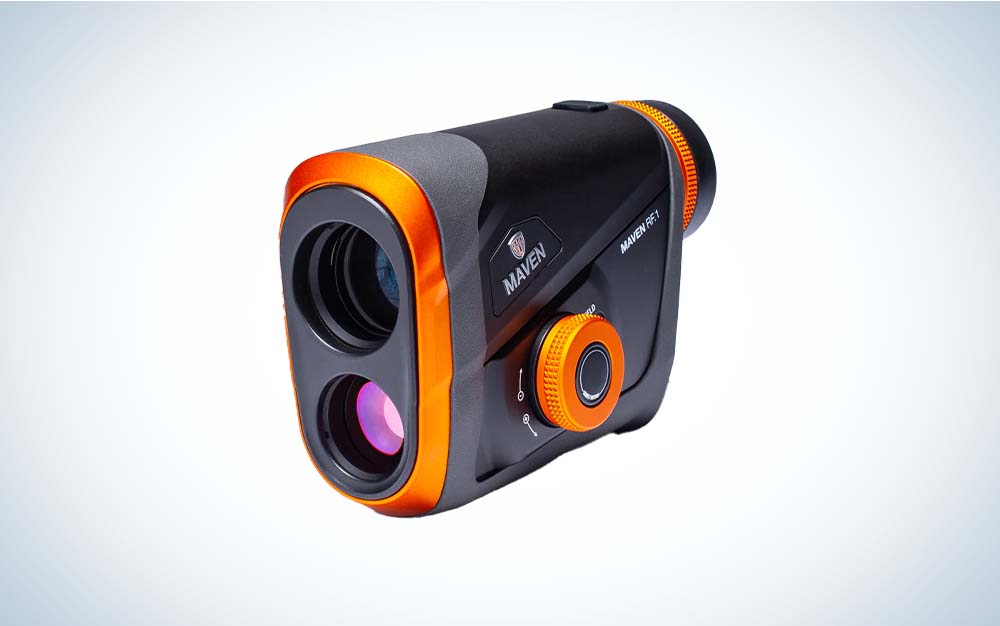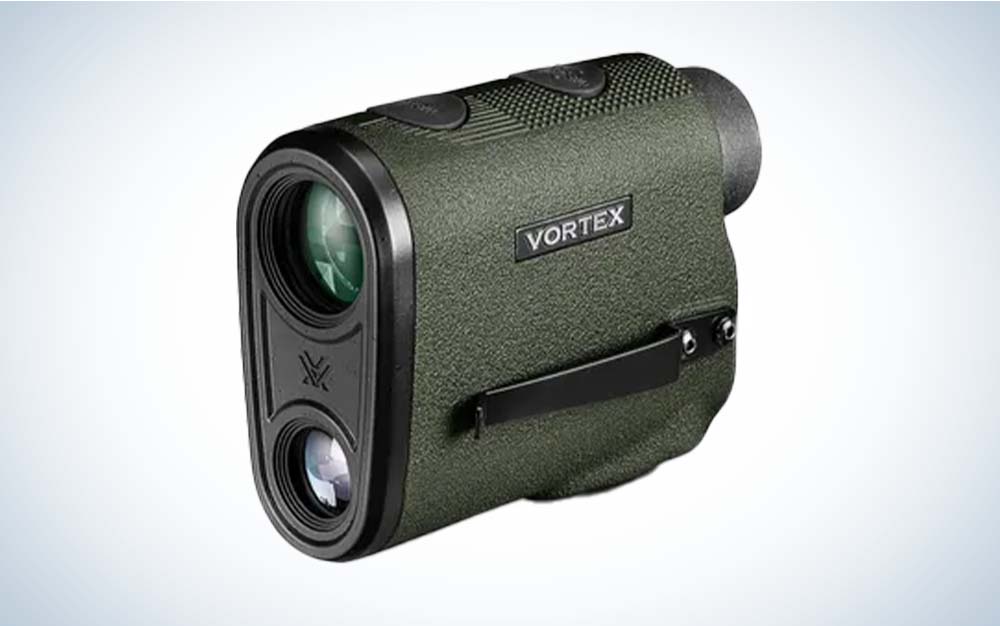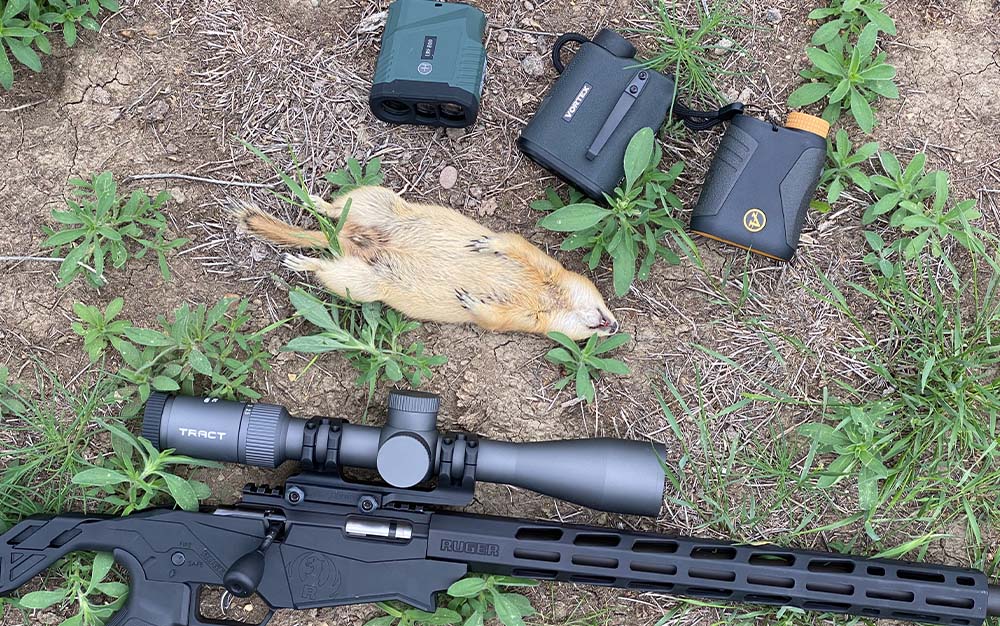|
Best for Bowhunters
|

|
Bushnell Broadhead
|
Check Price
|
LEARN MORE
|
Summary
Close-in precision for tree stand bowhunters.
|
|
Best for Tech Dummies
|

|
Maven RF.1
|
Check Price
|
LEARN MORE
|
Summary
A solid, straightforward rangefinder.
|
|
Best for All-Around Hunting
|

|
Vortex Diamondback HD 200
|
Check Price
|
LEARN MORE
|
Summary
No-frills mid-distance rangefinder for bow and rifle hunters.
|
The key to precision shooting and ethical hunting is knowing the exact distance to your target, and no matter the landscape or distance, there’s simply no alternative to a laser rangefinder to guide your shot. Happily, there’s a model that fits any budget and shooting style, though marketing jargon and external design can disguise the shortcomings and attributes of laser rangefinders.
In order to learn their capabilities, you have to test them in the real world, where you’ll use them. That’s what I did. I tested the best rangefinders in a variety of terrains, shooting situations, and light conditions in the hopes this review guides both your purchasing decisions and your bullet.
- Best for Mountain Hunting: Leica Rangemaster 2800.COM
- Best for Tech Dummies: Maven RF.1
- Best for Precision Shooting: Sig Sauer KILO10K ABS
- Best for All-Around Hunting: Vortex Diamondback HD 2000
- Best for Cost-Conscious Hunters: Hawke LRF 800
- Best for Whitetail Hunters: Athlon Midas 1 Mile
- Best for Bowhunters: Bushnell Broadhead
- Best for Golfers: Nikon CoolShot ProII Stabilized
- Best for Big-Game Hunters: Leupold RX-1500i TBR/W
How to Choose A Laser Rangefinder
The market is chock full of rangefinders with attributes designed for nearly every sort of shooting or hunting discipline. Want a rangefinder that will help you place your handloaded bullet on targets out to two miles and beyond? There’s a rangefinder for that. Or maybe you want a unit that will help you lob an arrow over a limb at 30 yards. There’s a rangefinder for that. There are also units that cover the basic needs of mid-distance shooters and hunters. So your first job is studying up on what units fit your particular needs.
Second, take a hard look at prices. Many entry-level rangefinders are available for under $150, but make sure these have good warranties on not only the optics but also the electronics that power the laser and computing software. Generally, you get what you pay for when it comes to these devices, and that el cheapo rangefinder may not last a second season. On the other hand, if you intend to only range targets in good light conditions inside 500 yards or so, a bare-bones unit may be all you need.
Look for units that have broad applications. The best have both rifle and bow modes, and many connect via Bluetooth to a mobile app that allows you to mate your rangefinder to your specific rifle loads, giving you precision that was unheard of just a few years ago.
Best for Mountain Hunting: Leica Rangemaster 2800.COM
Why It Made the Cut
The monocular Rangemaster 2800.COM packages superb optical clarity in a sleek and compact design with a fairly good ranging engine.
Key Features
- 7×24 configuration
- Ranges to 2,800 yards
- Red OLED display
Pros
- Best-in-class target sensitivity
- Excellent ergonomics
- Pairs with ballistics phone app
Cons
- Laser return is slower than peers
- Expensive
- Could use a tripod adapter
Product Description
Leica pretty much invented the category of laser rangefinding, and their products have been at the forefront of innovation and capability for over 20 years. Leica’s mobile app is one of the best shooting companions on the market, and pairs via Bluetooth with the rangefinder.
A nimble and elegant monocular rangefinder, the 7-power Rangemaster 2800.COM has such clear glass that you could almost use it in place of a binocular. Its rangefinding capability is pretty good, though I noted that it’s not quite as fast as its peers. What elevates this unit, and justifies its $749 price, is its superb target-acquisition capabilities and a very useful ballistic app that lets shooters range a target, and then receive a precise holdover value that corresponds to their load’s precise ballistics.
Best for Tech Dummies: Maven RF.1
Why It Made the Cut
This direct-to-consumer brand has made its name by offering very good optics without middleman pricing, and the RF.1 is no exception. The 7x magnification is just right for a variety of hunting and shooting purposes, and for users who don’t have the patience or digital skills to toggle through several modes in the internal display, the main functions are controllable on the outside of the unit and include targeting preference and the display intensity functions.
Key Features
- External mode selector
- 4,500 yard range
- Dimmable display knob
Pros
- Tripod mount
- External controls are easy to access and use
- 5-yard minimum ranging appeals to bowhunters
- Choice of five different reticle styles
Cons
- Very large external dimensions
- Real-world ranging limit at 3,800 yards
- Mode selector easy to inadvertently move
- No connection to ballistic app
Product Description
A very useful and durable rangefinder, Maven’s RF.1 has everything a big-game hunter needs. The external mode selector toggles between Field and Forest functions; Field for acquiring small, precise targets and Forest for acquiring targets behind veiling branches and rain. The rheostat dial that controls display intensity is a useful feature for hunters who want full display intensity in the middle of the day but subdued red LED for low-light conditions. Users can choose between line-of-sight and angle-compensated viewing preferences. I wish the unit paired with a ballistic app, but it’s a solid stand-alone rangefinder.
Best for Precision Shooting: Sig Sauer KILO10K ABS
Why It Made the Cut
A feature-rich rangefinding binocular, this unit has features aimed directly at competitive long-distance precision target shooters. The suite of capabilities includes five different ranging modes, both custom and pre-selected ballistic profiles, wind speed and direction, target mode, reticle selection, and even a compass. At over $2,000, it’s pricey but it’s cheaper than your buddy who’s lousy at spotting your long-range shots.
Key Features
- Laser rangefinding binocular
- Pairs with Sig’s ballistic app
- Uses Applied Ballistics’ bullet profiles
- Heads-up display provides environmental and ballistics info
Pros
- Pairs with Sig’s BDX system
- Red LED display provides distance-specific elevation and windage data
- Fully compatible with Garmin and Kestrel shooting accessories
- Ships with Multicam chest harness and Bluetooth wind meter
Cons
- At over $2,300, it’s a pricey unit
- Greenish coatings are optically distracting
- Requires pairing with app and Kestrel unit for full capability
Product Description
This rangefinding binocular has so many bells and whistles that most users will use only a fraction of its capability. But if you’re a long-range shooter who wants to receive precise holdover (and even more remarkably, windage hold-off) in the image plane of a binocular, the KILO10K is for you. I had a hard time getting yardage on reflective targets beyond 5,500 yards (about half the advertised 10,000 yards), but I did range deer at 3,300 yards, which is more than enough for any hunter and their best long range calibers. Still, I recommend stabilizing this unit on a tripod for best performance. Precision shooters should also use the mobile app to pour your specific load into this remarkable viewing and precision-aiming tool. Once all your custom settings are set (and the lenses, display, and even reticle tuned to your specific eyesight), let this hand-held whiz-bang device elevate your shooting game to an astonishing degree.
Best for All-Around Hunting: Vortex Diamondback HD 2000
Why It Made the Cut
Vortex has a new line of laser rangefinders, but the Diamondback HD 2000 occupies the happy middle, between the 4,000-yard Razor and the more modest Crossfire. With both line-of-sight and angle-compensated modes and a fast and precise ranging engine, the Diamondback will deliver ranges for just about any hunting scenario. The unit ships with a useful pouch and pocket clip, and the tripod mount adds to its versatility.
Key Features
- Red LED display
- Line-of-sight or angle-compensated modes
- Tripod mount
Pros
- Pebbled exterior is grippy
- Reversible pocket clip
- Fast and precise ranging engine
- Simple and bold display
Cons
- No Bluetooth connectivity to mobile app
- Single reticle
Product Description
Nothing earth-shaking here. The Vortex Diamondback HD 2000 is a straight-ahead mid-distance rangefinder that does its job—finding the distance to targets between 6 and 2,000 yards—with minimal fuss, and it clocks in at about $300. If you’re looking for a rangefinder to pair with a ballistic application, this isn’t your donkey. But if you want a simple and reliable hunting rangefinder, this unit is one of the best rangefinders for hunting in that category.
Best for Cost-Conscious Hunters: Hawke LRF 800
Why It Made the Cut
Considering that you can pay well over $2,000 for a laser rangefinder, this unit that costs well under $150 is both refreshing and enables hunters of every means to add a laser rangefinder to their kit, in order to be sharper, more effective hunters.
Key Features
- 6x25mm configuration
- Delivers rain, flag, and hunt modes
- Weight: 4.6 ounces
Pros
- Three ranging modes offer versatility
- 6-to-870 yard ranging capability
- Accessible cost
Cons
- Black LCD display hard to see in low light
- Build feels both blocky and flimsy
- Image is dark
- No scanning or angle-compensating modes
Product Description
This is the rangefinder for the rest of us. If you can’t afford to pay more than $200 for a competent laser rangefinder, and you’re willing to forego features like connectivity to a mobile app, angle-compensating, and scan mode, then this is a unit to consider. The Hawke LRF 800 delivers fairly fast ranging in a variety of light conditions. And it gets you in the ranging game for the cost of a few boxes of ammunition.
Best for Whitetail Hunters: Athlon Midas 1 Mile
Why It Made the Cut
Yes, this is a price-point laser rangefinder, but it has a number of features that elevate it from the entry-level to give it a lot of value for its $360 price tag.
Key Features
- Scan mode
- Angle-compensating mode
- Red LED display
Pros
- Close-in ranging to 8 yards
- Max distance to 1,500 yards
- Red LED display
Cons
- Feels flimsy
- No tripod mount
- Dark optics
Product Description
There’s not a lot of extras here, just a bare-bones laser rangefinder that can handle angle-compensated as well as line-of-sight aiming solutions. Hunters who want to track a moving target will appreciate the scan mode, and bowhunters will like the 8-yard close-in targeting. The Athlon Midas 1 Mile a good choice for hunters who might be in a tree stand or want to make an angled-adjusted shot in the foothills. It’s not going to reach out to the next township, but most of America’s deer hunters don’t need it to. They need a reliable mid-distance rangefinder, and Athlon’s Midas 1 Mile delivers.
Best for Bowhunters: Bushnell Broadhead
Why It Made the Cut
A laser rangefinder configured for bowhunters, the Broadhead combines many of Bushnell’s proprietary features, including the angle-compensating ARC technology for both bow and rifle hunters, close-in precision of .3-yard accuracy, and a ActivSynch reticle that adjusts for ambient light.
Key Features
- ActivSynch display automatically adjusts to ambient light
- Includes Bushnell’s ARC (Angle Range Compensation) mode
- Tripod mount
Pros
- Tripod mount
- Angle-compensating
- Fast, precise scanning mode
- Palm-swell ergonomics
Cons
- No connectivity to ballistics app
- Deer-target range limited to 500 yards
Product Description
An archery-configured laser rangefinder, this Bushnell unit has three features that make this an essential tool for bowhunters to keep in their bowhunting backpacks. The first and most important is the Angle Range Compensation (ARC) technology that is dialed down for hunters who post up in tree stands. Add the scanning mode, which allows hunters to track targets through veiling limbs, and the light-sensitive reticle, and you have a rangefinder that will serve mid-distance hunters through a wide range of environmental conditions.
Best for Golfers: Nikon CoolShot ProII Stabilized
Why It Made the Cut
While this particular unit is configured for golfers, the Nikon CoolShot ProII Stabilized has plenty of attributes for bowhunters. If you’ve ever tried to trigger a rangefinder when a bugling bull is closing the distance, then you know how your trembling hand can sour the deal. The CoolShot’s stabilization feature makes sure you get an accurate range reading even when you’re delaminating with the pressure of the shot.
Key Features
- Stabilization mode
- Fast scanning mode
- Two-tone LED display
Pros
- Gyroscopic stabilization
- Crisp OLED display
- Fast return rate
- 8-1,200-yard range
Cons
- Game-spooking white finish
- Configured more for golf than hunting
Product Description
A previous iteration of this stabilized unit was configured for hunters, with a low-glare black finish. That unit is no longer being manufactured, but that vibration-dampening feature is the CoolShot ProII’s best asset. The guts of this 6×21 monocular are fairly standard, with 8- to 1,200-yard ranging, a variety of target modes, and either line-of-sight or angle-compensated ranging. But the stabilization locks onto targets that might be hard to acquire in a strafing wind or when an approaching animal jangles your nerves.
Best for Big-Game Hunters: Leupold RX-1500i TBR/W
Why It Made the Cut
The latest in Leupold’s long line of RX rangefinders has increased yardage and sensitivity, the ability to add windage holds, an excellent inclinometer, and a faster laser engine. Instead of chasing the farthest ranging capability, Leupold’s 1500i is built for hunters who aim to limit their ranging to the reach of their rifles and bows, with ranging from 6 to 1,500 yards, and the ability to integrate ballistics from 25 ballistics groups.
Key Features
- 6x22mm monocular
- Recommends wind hold at every distance
- Bow and rifle modes
- “Trophy Scale” feature allows for game measurement
Pros
- True Ballistic Range/Wind technology
- DNA ranging engine
- Bow and rifle modes
- Mid-price point
Cons
- No tripod mount
- LCD display gets lost in dark backgrounds
Product Description
A laser rangefinder with all of the attributes a big-game hunter might want, the new 1500i TBR/W has a couple of features that will appeal to Westerners. The first is a very precise inclinometer that makes steep-angle shots as easy as ranging and holding on the adjusted distance. The second is a wind value that accounts for a 10mph crossing wind at any distance. The unit also features bow and rifle modes and half-yard accuracy to 125 yards, then 2-yard accuracy out to 1,000 yards.
FAQs
Q: How does a rangefinder work?
The simplest laser rangefinders work by measuring the time a laser beam leaves the device to when it returns. Obviously, this happens at the speed of light, so laser rangefinders have very precise clocks that can measure in nanoseconds. The more sophisticated laser rangefinders also have an inclinometer, or some level that can measure the angle of the device, which helps measure the angle-compensated distance between the unit and the target. And still others have software that combines the distance readings with the ballistics of your rifle, to help you adjust your aim for specific distances and angles.
Q: What’s the best rangefinder for under $200?
Is it possible to buy a serviceable laser rangefinder for under $200? The easy answer is yes. A couple of models to consider are Bushnell’s Prime 1300 or Prime 1700 units. The numeric designations in the models are a give-away for their ranging capabilities: the Prime 1300 is rated to range highly reflective targets at 1,300 yards, and the Prime 1700 at distances just over a mile. In the real world of deer hunting, their range is about 600 and 700 yards, respectively. The good thing about these units is that they both have incline-adjusting ranging as well as scanning modes.
You might also consider Hawke’s 400 LRF and 800 LRF models, both of which sell for under $170. The limitation to these models is that they provide only line-of-sight ranging, with no incline-adjusted aiming solution, and neither have scan modes. Lastly, Sig has a $152 rangefinder, the Buckmasters 1500, that has a bullet-drop compensation reticle that provides holdover dots out to 500 yards that conform to the bullet drop of eight different ballistic groups.
Q: Do I need a rangefinder with incline-adjusted ranging mode?
If you do most of your shooting and hunting in flat terrain, you might not need an inclinometer, but the minute you climb into a treestand to hunt deer or you try to make a shot on a target that’s slightly higher or lower than your gun or bow, you’ll want a rangefinder with the ability to find the “true” distance to an inclined target. At modest angles, say inside 6 degrees, with targets inside about 200 yards, you won’t see a huge difference in what’s called line-of-sight ranging and incline-adjusted ranging. But as both angles and distances increase, the linear distance can be several yards different from the angle-compensated distance. That means you’d shoot the legs off, say, a mountain goat standing 500 yards away on a ridge that’s 250 feet higher in elevation than you are. Or you’d miss entirely a 1,000 yard standard steel target that’s only 10 feet lower in elevation. Inclinometers are pretty much standard on most rangefinders, and you should get comfortable switching between angular and line-of-sight modes.
Q: Which rangefinders have the clearest glass?
Not all laser rangefinders are equal when it comes to their optics, and generally the models from companies that make binoculars and riflescopes have the best glass and clearest coatings. But here’s the deal: you really aren’t buying a laser rangefinder for its optical clarity; you’re buying it for the electronics—the laser and distance-computing software. All things being equal, I’d buy a unit with better and more sophisticated electronics. But you can’t range what you can’t see, and optics make a huge difference. I like units from Leica, Maven, and Leupold for the quality of glass in their builds, and in the coatings that not only accentuate your target, but also boost the visibility of the display.
Q: What are the best Sig rangefinders?
Sig has one of the most complete lines of laser rangefinders in the industry. Stepping up in price and performance is the entry-level Buckmasters 1500 ($152), and the KILO1000BDX ($250) that pairs with Sig’s versatile BDX system of sports optics. The KILO1600 will range deer-sized targets out to 800 yards and has both angle-modified and line-of-sight ranging and Sig’s ultra-fast ranging engine. Sig has developed a growing family of precision-shooting rangefinders, and the best of the monocular styles is the KILO8K-ABS, a 7x25mm unit that has a maximum range of 8,000 yards and uses Applied Ballistics Elite custom ballistics profiles along with onboard environmental sensors and a digital compass to churn out hyper-precise aiming solutions for just about any long-range target range.
Another monocular to consider is the KILO5K, which has a range of 5,000 yards and uses Applied Ballistics Ultralite ballistics curves but also pairs with Kestrel and Garmin devices for even more precise aiming, and with BaseMap for geo-location. It also pairs with Sig’s BDX family. Lastly, the wildly sophisticated KILO10K-ABS rangefinding binocular brings in all the precision shooting software with a heads-up display that provides all relevant ballistics information—including range, elevation and wind holds, and bullet velocity and energy at target—in the display. So making hyper-informed aiming decisions is as easy as ranging the target, and following directions in the display.

A solid rangefinder can help you dial in your shots on even the smallest targets. Andrew McKean
Evaluating Laser Rangefinders
Like most sports optics, including the best binoculars for hunting, the best way to figure out the best laser rangefinders for hunting is to test a few units in a variety of outdoor conditions.
Ideally, you want to test a couple of units against each other in the field. Manufacturer’s claims of ranging capability are usually either exaggerated or they’re based on the most reflective types of targets, not deer- or coyote-sized targets that many of us expect to range in the field. Many are sensitive to various light conditions, and still others have a hard time differentiating between a barn and the shrub behind the barn. And some have such clunky interfaces that changing modes or even display brightness intensities can be like programming an old DOS computer.
For this test, I gathered nine units that cover the spectrum from entry-level to sophisticated. There are obviously dozens more available on the market, but the group I tested represents most brands and capabilities.
I first tested their close and far ranging capabilities on a wide variety of targets, from 3-D archery targets to grain bins, forested hillsides, and cattle. I tested in full daylight and in twilight conditions, and in fog and rain. I used both slow, deliberate ranging and scanning modes, measuring not only target sensitivity but also the rate of return. Some units are fast but imprecise while others are slower but deliver exceptionally consistent distances. I also tested every mode, whether line-of-sight or incline-adjusted ranging, various reticles, and different target modes.
Lastly, I confirmed that units with applied ballistics software or an ability to link to a mobile app could deliver the custom ranging solutions that I demanded. Pretty much every unit in my test delivered what I’d call good-enough ranging solutions, but some are much more user-friendly and precise. My main take-away: laser rangefinders have such infinite variety and capability that you want to shop around for the unit that fits your specific expectations and hunting/shooting style.
Final Thoughts
The best laser rangefinders for hunters is the one that a) you can afford, and b) that delivers consistent yardage to a wide variety of targets in varying light conditions. Once you figure out the sweet spot for each rangefinder, then learn how to maximize its performance when conditions aren’t perfect, as that’s exactly what you’ll find in the hunting fields. Either way, commit to buying and using a rangefinder. There’s simply no excuse for missing a shot because you didn’t know the precise distance or how your gun and bullet will perform at that specific range.
The post The Best Rangefinders for Hunting in 2022 appeared first on Outdoor Life.
By: Andrew McKean
Title: The Best Rangefinders for Hunting in 2022
Sourced From: www.outdoorlife.com/gear/best-rangefinders-for-hunting/
Published Date: Sat, 18 Sep 2021 16:00:00 +0000
----------------------------------------------
 Backyard GrillingWeekend WarriorsAdvice from DadBeard GroomingTV Shows for Guys4x4 Off-Road CarsMens FashionSports NewsAncient Archeology World NewsPrivacy PolicyTerms And Conditions
Backyard GrillingWeekend WarriorsAdvice from DadBeard GroomingTV Shows for Guys4x4 Off-Road CarsMens FashionSports NewsAncient Archeology World NewsPrivacy PolicyTerms And Conditions
